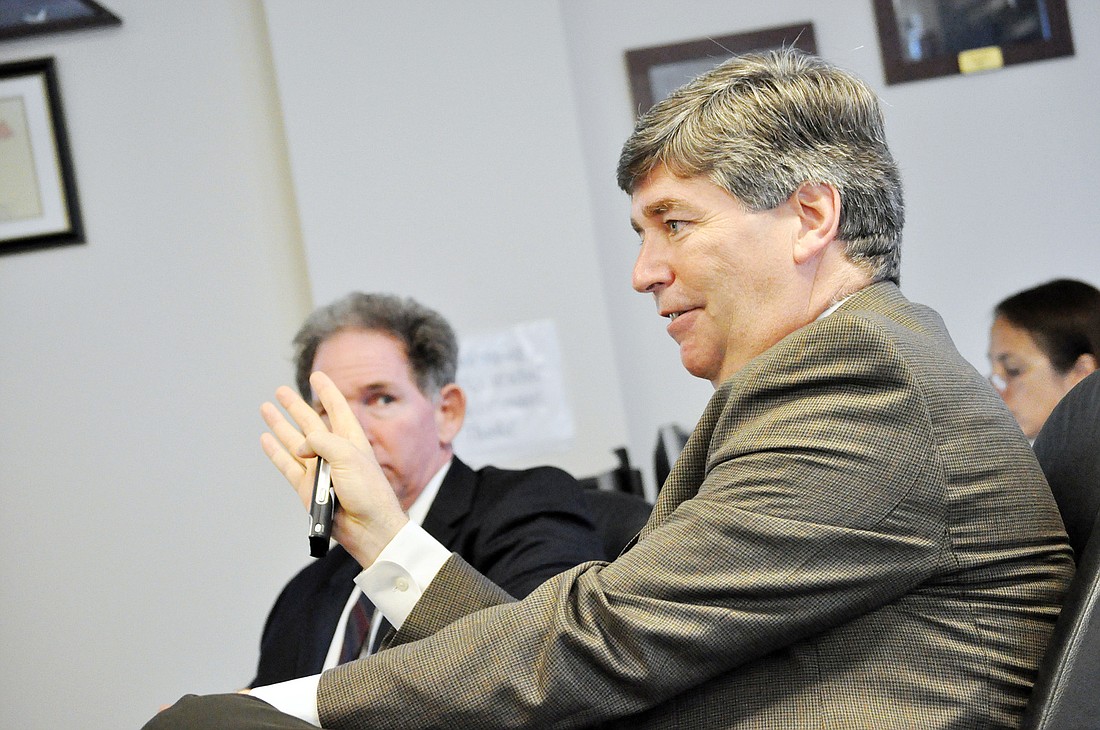- April 24, 2024
-
-
Loading

Loading

Code enforcement, law enforcement, streets and the fire department are all targets for trimming more fiscal fat during this year’s budget talks. They comprise two-thirds of the general fund.
If the Palm Coast City Council plans to cut its budget any further, those cuts will have to come from the “boots on the streets,” Palm Coast Finance Director Ray Britt told the City Council July 5.
Britt presented a breakdown of prior budget reductions the city has endured. Code enforcement, law enforcement, streets and drainage and the fire department are the four areas that could be in the financial crosshairs when the City Council begins budget discussions.
“If any cuts are going to be made, those are the only departments where you’re going to be able to find the amount of money to be able to make up for the decrease in property taxes and general fund revenues,” Britt told the City Council.
According to Britt, those four departments alone make up for about $17 million of the 2011 general fund budget — about 66% of the fund.
According to the latest numbers released July 1 by the Flagler County Property Appraiser, the city’s decrease in property values was 12.8%. (See Page 3 for the full story.)
At the current millage rate of 3.50 mills, that would result in revenue decrease of $1.9 million.
“If you’re going to decrease revenue, that’s fine — but you have to reduce expenditures,” City Manager Jim Landon said.
Britt’s presentation highlighted the time frame from 2007 to this year.
The recession, Britt said, officially started in 2007. That year, property values were at about $6.2 billion, while the total millage rate was 3.25 mills, or $3.25 for every $1,000 of taxable value.
The general fund in 2007 was $25.43 million, and the city had 228 full-time equivalent employees. In 2011, the estimated expenditures total about $26 million. The change is $640,657, or a 2.5% increase, compared to 2007. However, there are the equivalent of 216 full-time employees in 2011, a 5.2% decrease.
In other words, the city’s population has grown and expenses have grown, but city staff has contracted.
“We’re doing things with fewer people compared to our population,” Britt said.
An example of doing more with less is in the city’s parks and facilities department. The estimated expenditures from 2007 to 2011 represent a decrease of $52,520, or 4.9% . However, the number of employees, 12, has remained the same.
These same 12 people are taking care of more parks, Britt said, citing Waterfront and Ralph Carter parks, both of which opened after 2007.
But not everything has been slashed.
Code enforcement, law enforcement and fire are all departments that have increased in expenditures since 2007. Specifically, fire has grown from $5.5 million to $7.47 million, a 35.9% increase. The equivalent of 18 new full-time employees have been added since 2007. Two new fire stations and a new truck have been added.
And Britt knows the future might not necessarily mean more money — at least possibly not until 2013. “Revenues are continuing to decline,” he said.
Britt noted that state revenues are up about 9% nationwide. However, local government revenues are still down about 1%.
“Property taxes are lagging, and that’s what local governments rely on,” Britt said. “The thing to keep in mind is everything is cyclical. We just need to prepare for the bad times during the good times.”
Landon also stressed the importance of reducing expenditures if revenues are reduced.
“You have to reduce expenditures accordingly and not take savings accounts and pretend like you’re balancing a budget,” Landon said. “Revenues and expenditures need to match. You need to stay within your means.”
Old Kings resurfacing on the horizon?
Also at the July 5 regular meeting, Landon said the two-lane portion of Old Kings Road will not be repaved by the developers.
The property owners or developers, Landon said, had agreed to tax themselves to pay for the road improvements.
However, that is not happening any time soon, according to Landon.
“I’ve instructed our street department to include the two-lane section in the annual improvements, and it will be included and ranked,” Landon said.
If it’s ranked high enough and the money is there, then the two-lane portion of Old Kings Road would be resurfaced.
Over the past 10 years, the roads have been resurfaced via the half-cent sales tax.
Landon said the goal is to have the two-lane portion look similar to the stretch from Town Center Boulevard south to State Road 100.
Contact Andrew O’Brien at [email protected].